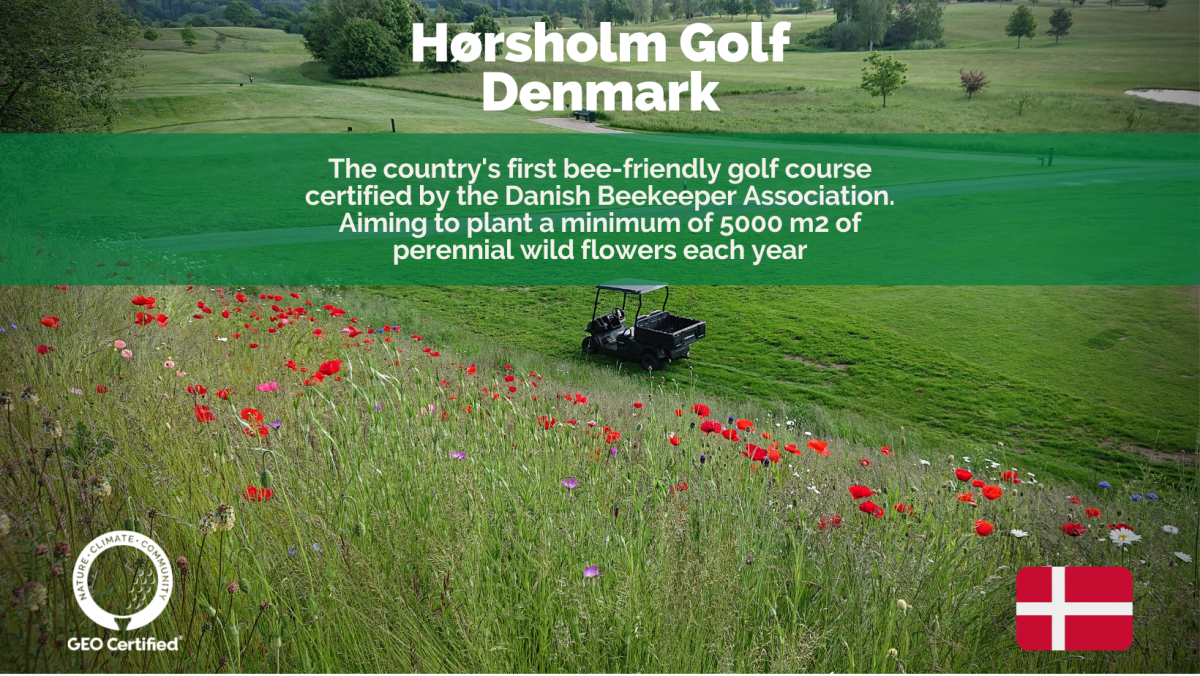16 Dec 2020
Blog - Jamie Graham
How to make your golf course bee-friendly
Globally, many bee species are under threat from climate change, habitat loss and use of pesticides, amongst other things. Bees play a critical role in our food supply chain through pollination and golf courses can make a positive difference to their numbers and health.
Here are five ways you can boost bee numbers at your course and play your part.

1. Could you mow certain areas less often?
Allowing areas of your course to become naturalized can enable a win-win situation. Not only could you save time and money but reducing mowing frequency can result in more wildflowers being able to grow and provide a source of food for pollinators.
Many courses are actively reducing the amount of maintained land in their care to benefit biodiversity and enhance the aesthetic for golfers. In this example of allowing areas of maintained rough to rewild, Hirsala Golf in Finland was able to reduce maintained rough areas by 13% of the course total which equates to around 2Ha.
Naturalization is a vital strategy in greenkeeping to help safeguard the future of bees and their critical role in life on earth.
2. Is there space for a wildflower meadow on your course?
There are areas of most golf courses that are largely unused and don’t come into play very often. A great way to bring a splash of colour to your course and attract bees is to plant a wildflower meadow. Hørsholm Golf went a step further by becoming Denmark’s first ‘Certified Bee-friendly’ course and planted Linum perenne, Calendula officinalis and Chrysanthemum leucanthemum among others.
Golf Les Iles in Italy identified areas around walkways, in the woods and around lakes as being perfect for wildflowers to attract more bees. This initiative has had the additional benefit of reducing maintenance costs and noise pollution. With four out of every five wild and agricultural plants depending on pollination to survive, creating wildflower meadows or areas on your course is something to be proud of.
And at Minthis in Cyprus, the club planted 100,000 bee-friendly plants and local trees in the Natura 2000 area at Minthis, which contribute to increased pollination. This is part of its ‘Bee Aware - Bee Responsible’ Corporate Social Responsibility programme.
3. Can you add beekeeping to your greenkeeping skills?
Golf courses are a perfect environment for beehives, and many courses have their own. As well as making a positive difference to nature, the honey from hives can also be gathered and sold. Golfclub Capelle, Dundonald Links and many others have created an additional revenue stream and a fantastic souvenir for visitors.
Even if your club doesn’t sell the honey, it can be used by chefs in the clubhouse to add an authentic local flavour to dishes. Using honey produced on-site helps you play a part in reducing your carbon footprint too.
4. Are you doing all you can to provide bees with a home?
There are over 240 species of solitary bee in the UK alone. While they don’t produce honey, they are essential pollinators. At Banchory Golf, they provided bee hotels and created habitats that allowed them to hibernate in bunker faces and sandy outcrop areas around the first tee.
The links habitat at Royal St David's Golf Club in Wales features a lot of bare sand which is great for mining bees. The club has invested a lot of effort in removing gorse and scrub to expose clean sand which also helps wasps, sand lizards and birds.
5. What about pesticides?
Pesticides are widely recognised as part of a ‘perfect storm’ for the decline of bee populations across the world, and whilst golf courses are relatively light users of chemicals, it is important to minimise all potential impacts. The most certain way to ensure that is to avoid pesticide use altogether, which is being achieved by some clubs in some countries - whether because it’s the law or through voluntary action. At the very least, such chemicals should really be a last resort. Here are some examples of clubs that have become pesticide-free:
At Golfplatz Klosters in Switzerland, Alpine meadow roughs around the course – harvested by local farmers – are designated pesticide and fertilizer-free areas. And in Sweden, Hofgård Golf Club embarked on a project to slowly eliminate the use of pesticides and reduce inputs of fertiliser. Han Golf in Finland has been pesticide-free since 2018 and found an alternative way to protect its greens from disease.
Takeaway action: Watch the video below for great tips on how to create a wildflower meadow.